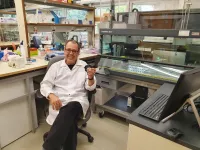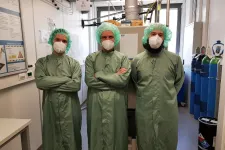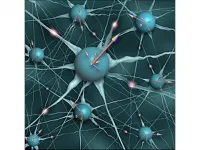An end to invasive biopsies?
Hebrew University researchers advance simple and inexpensive diagnostic blood test
2021-02-08
(Press-News.org) In diagnostic medicine, biopsies, where a sample of tissue is extracted for analysis, is a common tool for the detection of many conditions. But this approach has several drawbacks - it can be painful, doesn't always extract the diseased tissue, and can only be used in a sufficiently advanced disease stage, making it, in some cases, too late for intervention. These concerns have encouraged researchers to find less invasive and more accurate options for diagnoses.
Professor Nir Friedman and Dr. Ronen Sadeh of the Life Sciences Institute and School of Computer Engineering have published a study in Nature Biotechnology that shows how a wide range of diseases can be detected through a simple blood test. The test allows lab technicians to identify and determine the state of the dead cells throughout the body and thus diagnose various diseases including cancers and diseases of the heart and liver. The test is even able to identify specific markers that may differ between patients suffering from the same types of tumorous growths, a feature that has the potential to help physicians develop personalized treatments for individual patients.
The test relies on a natural process whereby every day millions of cells in our body die and are replaced by new cells. When cells die, their DNA is fragmented and some of these DNA fragments reach the blood and can be detected by DNA sequencing methods. However, all our cells have the same DNA sequence, and thus simply sequencing the DNA cannot identify from which cells it originated. While the DNA sequence is identical between cells, the way the DNA is organized in the cell is substantially different. The DNA is packaged into nucleosomes, small repeating structures that contain specialized proteins called histones. On the histone proteins, the cells write a unique chemical code that can tell us the identity of the cell and even the biological and pathological processes that are going on within it. In recent years, numerous studies have successfully developed a process where this information can be identified and thus reveal abnormal cell activity.
A new approach advanced by Hebrew University researchers, Professor Friedman and Dr. Ronen Sadeh is able to precisely read this information from DNA in the blood and use it to determine the nature of the disease or tumor, exactly where in the body it's found and even how far developed it is.
The approach relies on analysis of epigenetic information within the cell, a method which has been increasingly fine-tuned in recent years. "As a result of these scientific advancements, we understood that if this information is maintained within the DNA structure in the blood, we could use that data to determine the tissue source of dead cells and the genes that were active in those very cells. Based on those findings, we can uncover key details about the patient's health," Professor Friedman explains. "We are able to better understand why the cells died, whether it's an infection or cancer and based on that be better positioned to determine how the disease is developing."
Along with the clear diagnostic benefits of this process, the test is also non-invasive and far less expensive than traditional biopsies. Dr. Ronen Sadeh said, "We hope that this approach will allow for earlier diagnosis of disease and help physicians to treat patients more effectively.
Recognizing the potential of this approach and how this technology can be so beneficial for diagnostic and therapeutic purposes, we set up the company Senseera which will be involved with clinical testing in partnership with major pharmaceutical companies with the goal of making this innovative approach available to patients."
INFORMATION:
[Attachments] See images for this press release:

ELSE PRESS RELEASES FROM THIS DATE:
2021-02-08
In certain materials, electrical and mechanical effects are closely linked: for example, the material may change its shape when an electrical field is applied or, conversely, an electrical field may be created when the material is deformed. Such electromechanically active materials are very important for many technical applications.
Usually, such materials are special, inorganic crystals, which are hard and brittle. For this reason, so-called ferroelectric polymers are now being used. They are characterised by the fact that their polymer chains exist simultaneously in two different microstructures: some areas are strongly ...
2021-02-08
A study has described genetic changes in patients with the most common form of hereditary kidney disease that affects an estimated 12.5 million people worldwide. The research, which focussed on Polycystic Kidney Disease (PKD) in Ireland, provides insights into PKD that will assist doctors and patients in the management of this of inherited condition.
The study, led by researchers from the RCSI University of Medicine and Health Sciences, is published in the European Journal of Human Genetics.
In the research, a cohort of 169 patients with PKD in Ireland were analysed. The genetic changes were identified in up ...
2021-02-08
Results from a new study which draws on survey data collected during the peak of the first wave of the pandemic suggests that being forced to slow down life, as a consequence of lockdown, has had significant, positive impacts for many people and their families.
The research, recently published in the British Journal of Psychiatry from a team at the University of Bath with international colleagues, analysed survey results from 385 caregivers of children aged 6-16 both in the UK and Portugal. Individuals completed an online questionnaire between 1 May 2020 and 27 June 2020.
This cohort had ...
2021-02-08
Swapping the car for walking, cycling and e-biking even just one day a week makes a significant impact on personal carbon emissions in cities.
'Active transport' - cycling, e-biking or walking - can help tackle the climate crisis according to a new study led by the University of Oxford's Transport Studies Unit and including researchers from Imperial's Centre for Environmental Policy as part of the EU-funded project PASTA: Physical Activity Through Sustainable Transport Approaches.
Meeting greenhouse gas emissions reduction targets requires a significant move away from motorised transport. The team found that shifting to active transport could save as ...
2021-02-08
Molecular iodine, a major emission from the ocean, can quickly convert to iodic oxoacids even under weak daylight conditions. These oxoacids lead rapidly to aerosol particles that significantly affect climate and human health.
Iodine-containing vapors that are emitted from oceans are a major source of aerosol particles. "Despite their importance to the climate, the formation of marine particles has been poorly understood," says Siddharth Iyer, Postdoctoral Researcher in Aerosol Physics Laboratory at Tampere University.
In this research, the formation of aerosol particles form from iodine-containing vapours under marine boundary layer conditions were studied. The experiments were carried out in the ultra-clean CLOUD chamber in CERN, where the nucleation and growth rates as well as ...
2021-02-08
Cells, like humans, cast votes to make decisions as a group. But how do they know what to vote for? Researchers at the Francis Crick Institute and King's College London have uncovered how cells actively seek information in order to make faster and better collective decisions to coordinate the growth of new blood vessels. This provides a new basis for understanding intelligence in cells.
The process of how cells precisely and quickly coordinate action when they create new tissue is complex. They must collectively decide which cells should take on specific jobs and ensure that not too ...
2021-02-08
Is a quantum machine really more efficient than a conventional machine for performing calculations? Demonstrating this 'advantage' experimentally is particularly complex and a major research challenge around the world1. Scientists from the CNRS2, the University of Edinburgh (Scotland) and the QC Ware, Corp., (France and USA) have just proved that a quantum machine can perform a given verification task in seconds when the same exercise would take a time equivalent to the age of the universe for a conventional computer. For this demonstration, they combined a complex interactive algorithm that solves a certain type of mathematical problem with limited information and a simple experimental photonics ...
2021-02-08
Goal 7 of the Sustainable Development Goals (SDGs) aims to ensure access to affordable, reliable, sustainable and modern energy for all by 2030. Yet according to new research by Copenhagen Business School the poor planning and execution of decarbonisation strategies in emerging markets challenges the aims of Goal 7.
"In the effort to produce renewable energy and decarbonise their economies, emerging countries have neglected the effect on marginalised populations, which could ultimately prove unsustainable for all," says Assistant Professor Jacobo Ramirez from the ...
2021-02-08
An important class of challenging computational problems, with applications in graph theory, neural networks, artificial intelligence and error-correcting codes can be solved by multiplying light signals, according to researchers from the University of Cambridge and Skolkovo Institute of Science and Technology in Russia.
In a paper published in the journal Physical Review Letters, they propose a new type of computation that could revolutionise analogue computing by dramatically reducing the number of light signals needed while simplifying the search for the best mathematical solutions, allowing for ultra-fast optical computers.
Optical or ...
2021-02-08
A way of using machine learning to more accurately identify patients with a mix of psychotic and depressive symptoms has been developed by researchers at the University of Birmingham.
Patients with depression or psychosis rarely experience symptoms of purely one or the other illness. Historically, this has meant that mental health clinicians give a diagnosis of a 'primary' illness, but with secondary symptoms. Making an accurate diagnosis is a big challenge for clinicians and diagnoses often do not accurately reflect the complexity of individual experience or indeed neurobiology.
Clinicians diagnosing psychosis, for example, would frequently regard depression as a secondary illness, with implications for treatment decisions which focus more on ...
LAST 30 PRESS RELEASES:
[Press-News.org] An end to invasive biopsies?
Hebrew University researchers advance simple and inexpensive diagnostic blood test



